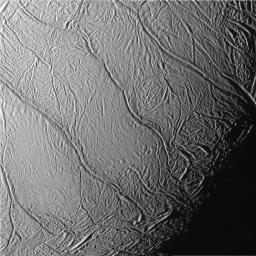Enceladus' Tiger Stripes

A lot of big news today about Enceladus as all the major instruments on Cassini reported their results. Most of the results revolve around the four prominent fractures in the south polar region known collectively as the "tiger stripes". These "stripes" are actually tectonic fractures, 140-170 km long and a couple of hundred meters deep. In the IR3 filter on the Cassini Narrow Angle Camera, sensitive to infrared light around 920 nanometers in wavelength, the fractures are surrounded by dark material lying between 2-5 km on either side of the fractures. When combined with the green and UV3 filters for stretched color images, the stripes appear blue to blue-green. On one of the stripes, a darkish spot, 3 km in diameter can be seen.
To sum up what we have learned today from VIMS, we know that the coarse-grained ice along the edges of the tiger stripes consists of crystalline ice (based on an absorption at 1.65 microns, not seen elsewhere on the satellite), which only forms at temperatures above 110 K. These crystals will degrade over time after cooling below 110 K thanks to the radiation environment, in a few decades up to a thousand years. This is what led to the VIMS teams claim that the fractures are young, less than 1000 years old, maybe even 10 years or younger. However, they are basing this on compositional evidence of the crystallinity of the ice. The crystalline ice could be ice brought up to the surface after the most recent eruption, not necessarily signalling that the fractures themselves are 10-1000 years old (though we couldn't rule it out, no craters larger than 400 meters or so have been found south of 70 degrees south latitude). VIMS also found simple organics along the fractures with a similar distribution of crystalline ice, based on an absorption at 3.44 microns.
So how did that material, crystalline ice which requires relatively warm temperatures (> 110 K), which appear to have coarse grains based on other VIMS measurements and ISS color spectra, and simple organics get there? INMS, as mentioned below, measured mostly water vapor above the south pole, along with N2, CO2, Hydrogen, and 1-2% CH4 and C2H2. So one could envision the plume scenario powered by a water-ammonia diapir almost directly below the south pole, where water vapor escapes from fresh fractures in the crust. The material with the lowest energy will be deposited just adjacent to the fractures and the material with higher energies will form a plume and then a transient, patchy atmosphere. So far, no nitrogen-bearing compounds in spectra of Enceladus and only hints of CO2 have been observed. But still, depsosition from a plume, rather than sublimation of fine-grained, amorphous ice seems reasonable. It is possible, though, that surface ices bordering the warmer fractures were transformed into crystalline, coarse-grained ice from the heat coming from the fractures. However, the simple organics, found no where else on the satellite (in fact the spectra of the rest of the satellite mirrors laboratory-quality water ice), would still need to be explained.


1 Comments:
Hello Jason,
If the ridges really are blue-green, that implies that there is absorption somewhere in the range yellow-orange-red. I suppose that we as yet cannot say whether the absorption is continuous or whether there are discrete bands. Has the Cassini team released an analysis of the strength of the absorption at 900 nm?
thank you,
martin
Post a Comment
<< Home